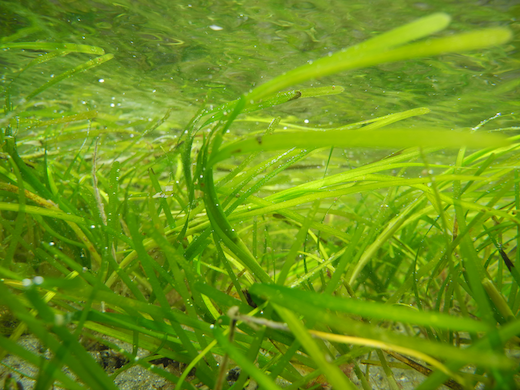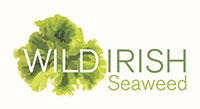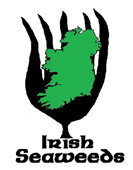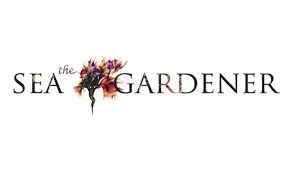Zostera marina Linnaeus
Includes Zostera angustifolia, a very similar entity with narrow leaves, although some authors consider that it should be treated as a separate species.
Common names: Eelgrass, Common Eelgrass, Wigeon grass, Broad-leaved grass wrack, Marlee, Sedge, Slitch, Sweet Sea-grass (Eng.). Bilearach (Irish and Scots Gaelic) Zostère marine (Fr.). Da ye zao (Chinese).
Description: Perennial, grass-like but with longer and broader leaves than most grasses; 20-50 cm long (occasionally to 110 cm), 5-10 mm wide, with 5-11 veins and rounded leaf tips, developing at intervals in groups from rhizoids ramifying extensively in the substratum; the leaf sheath forms a tube around stem; reproductive shoot terminal, branched and up to 15 mm long; inflorescences consisting of peduncles 15-100 mm, free portion 2-3 cm; spathes 10 or more, sheath 4-8 cm; blade 5-20 cm; spadix linear; staminate and pistillate flowers 1-20, apex acute or mucronate. Staminate flowers: bracts absent or rarely 1 subtending most proximal flower; pollen sacs 4-5. Pistillate flowers: ovary 2-3 mm, style 1-3 mm. Fruits ellipsoid to ovoid, 2-5 mm, often beaked, with 15-25 distinct ribs; rhizome with fibre bundles in the outermost layer of cortex. Flowering in spring and early summer
Habitat: intertidal in pools with shelly sand down to 10 m in sand and find gravel, often forming dense swards in the subtidal, supporting a diverse fauna and flora and may act as a nursery for fish and shellfish. Blades in sand tend to be narrower than those in mud. Picture above is plants in pools at Finavarra, Co. Clare, Ireland.
Key characteristics: One of two marine grasses in NE Atlantic; Zostera noltei (also known as Z. nana and as Z. noltii) occurs in estuaries high up in the intertidal on shelly mud.
Link: Information above partly modified from MarLin and Flora of North America.
Distribution: Common all around Britain and Ireland but most abundant on W and SW coasts. Widespread in N Hemisphere, adapted to the cold waters of the North Atlantic and North Pacific. In Europe found from the Arctic of N Norway south to the Spain; western and eastern basins of the Mediterranean and in the Black Sea. In the western Atlantic from Newfoundland south to North Carolina. In the Pacific from Alaska south to Baja California, and from Pacific Russia, Japan, Korea south to China, Myanmar and Thailand. It is particularly abundant in the Baltic where it grows well at 5 ppt.
Uses:
Sea-grass was used in historical times for thatching purposes, and it was supposed to last longer than straw. It was also used for stuffing matresses and pillows and as an insulating material. Intertidal and shallow subtidal swards are an important feeding resource for wildfowl in Britain and Ireland, particularly Brent Geese and Wigeon.
Decline: The pathodgenic slime mold Labryrinthula zosterae Porter & Muehlstein (Phylum Labyrinthulomycota), not described until 1991, caused the so-called "Wasting disease" of Zostera maina resulting in large-scale losses of eelgrass beds in the 1930s; localized populations are said to be still affected by the slime mold today.






